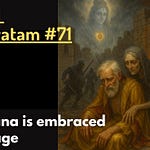In this material world, we can observe that a creator is always different from the elements used in his creation. An artist may use paint to create artwork, a builder may use bricks to build a house, and so on. The builder (the efficient cause) is different from the bricks (the material cause) and when the bricks are transformed into the house, they cease having a separate existence, becoming something else. In the end, the three things are different from each other. This idea is very familiar to us because the same logic applies to all kinds of material creations.
However, when we study the nature of the Supreme Brahman and the creation of the material universes, we come to an apparent contradiction. The Supreme Brahman is described in the Upanisads, and the Vedas in general, as both the efficient cause (nimitta) and the material cause (upādāna). In other words, Brahman is both the creator of the material manifestation and the substance from which the material universes are made. At the same time, Brahman is also described as unchangeable and unmaterial.
These ideas may seem quite dificult to reconcile. If Brahman is spiritual and eternal, how can He be the cause of the temporary material world? If Brahman is unchangeable, how can He create the material manifestation out of Himself?












